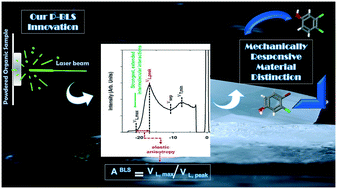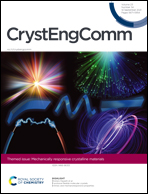Elastic anisotropy of mechanically responsive molecular solids†
Abstract
The mechanical properties of organic molecular solids have progressed well beyond simple brittle fracture to encompass a broad spectrum of unique behaviors: flexibility in one- and two-dimensions, twisting, bending and even jumping. Design models are under construction to help navigate property expression through crystal engineering, though no clear consensus is available on how structural and energetic (interaction anisotropy) factors combine to generate a specific mechanical response. Subtle differences in intermolecular strength or spatial organization have significant impact on material mechanics, and while diffraction and computational data have been instrumental to recent success, a need has developed for new tools that better quantify the interaction anisotropy. Herein we introduce a unique application of powder Brillouin light scattering (p-BLS) to assess the elastic anisotropy of molecular solids. We hypothesize that the width of the longitudinal frequency distribution directly correlates with a material's elastic anisotropy. We introduce a new characteristic frequency (νL,peak) and define our elastic anisotropy index (EAI) as the ratio of νL,max/νL,peak. This EAI is validated against a library of 24 molecular solids with experimentally determined stiffness tensors (Cij) used to calculate previously reported EAIs. Using energy frameworks and sound velocity polar plots, the elastic anisotropy from p-BLS is extended as an experimental window into the interaction anisotropy in organic molecular solids. We conclude with an application of p-BLS to mechanically responsive solids – 3,4-dichlorophenol and 4-bromo-3-chlorophenol – to discriminate elastic flexibility and plastic bending from the perspective of interaction anisotropy.

- This article is part of the themed collections: Supramolecular & Polymorphism and Mechanically responsive crystalline materials


 Please wait while we load your content...
Please wait while we load your content...